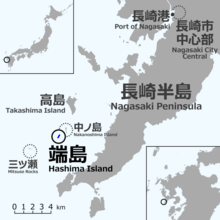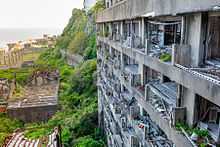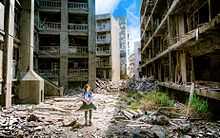Hashima Island
| Native name: <span class="nickname" ">端島 Nickname: Battleship Island | |
|---|---|
|
Aerial view | |
 | |
| Geography | |
| Location | East Asia |
| Area rank | none |
| Country | |
|
Japan | |
| Prefecture | Nagasaki Prefecture |
| Demographics | |
| Population | 0 (as of 2014) |

Hashima Island (端島 or Hashima — -shima is a Japanese suffix for island), commonly called Gunkanjima (軍艦島; meaning Battleship Island), is an abandoned island lying about 15 kilometers (9 miles) from the city of Nagasaki, in southern Japan. It is one of 505 uninhabited islands in Nagasaki Prefecture. The island's most notable features are the abandoned and undisturbed concrete apartment buildings and the surrounding sea wall.
The island was known for its undersea coal mines, established in 1887, which operated during the industrialization of Japan. In 1959, the 6.3-hectare (16-acre) island's population reached its peak of 5,259. The mine was closed in 1974, and all the residents left the island soon after. Due to lack of maintenance several buildings have collapsed since, and other buildings are subject to breakage. However, certain collapsed exterior walls have been restored.
The interest for the island re-emerged in 2000s among enthusiasts for ruins, and they gradually became a tourist attraction of a sort. Travel to Hashima was re-opened for tourists on April 22, 2009. Increased interest in the island resulted in an initiative for its protection as a site of industrial heritage. In 2008, the Japanese Agency for Cultural Affairs added "The Modern Industrial Heritage Sites in Kyushu and Yamaguchi" complex to the tentative list, and there is an initiative for it to be included into the UNESCO World Heritage. Among other shows, Hashima featured in the 2012 James Bond film Skyfall and in a 2009 episode of History Channel's Life After People.
History
The island was populated from 1887 to 1974 as a coal mining facility. The island's most notable features are the abandoned and undisturbed concrete apartment buildings and the surrounding sea wall. The island has been administered as part of Nagasaki city since the merger with the former town of Takashima in 2005.
It is known for its coal mines and their operation during the industrialization of Japan. Mitsubishi bought the island in 1890 and began the project, the aim of which was extracting coal from undersea mines. The required laborers were supplied from Japanese colonies during the industrialization of Japan.[1] They built Japan's first large concrete building (9 stories high),[2] a block of apartments in 1916 to accommodate their burgeoning ranks of workers. Concrete was specifically used to protect against typhoon destruction. In 1959, the 6.3-hectare (16-acre) island's population reached its peak of 5,259, with a population density of 835 people per hectare (83,500 people/km2, 216,264 people per square mile) for the whole island, or 1,391 per hectare (139,100 people/km2) for the residential district.[3]
As petroleum replaced coal in Japan in the 1960s, coal mines began shutting down all over the country, and Hashima's mines were no exception. Mitsubishi officially announced the closing of the mine in 1974, and today the buildings are empty and the population is zero. Travel to Hashima was re-opened on April 22, 2009, after 35 years of closure.[4]
Etymology
Battleship Island is an English translation of the Japanese nickname for Hashima Island, Gunkanjima (gunkan meaning battleship, jima being the rendaku form of shima, meaning island). The island's nickname came from its apparent resemblance to the Japanese battleship Tosa.[5]
Current condition

The island is increasingly gaining international attention not only generally for its modern regional heritage, but also for the undisturbed housing complex remnants representative of the period from the Taishō period to the Shōwa period. It has become the frequent subject of discussion among enthusiasts for ruins.
Since the abandoned island has not been maintained, several buildings have already collapsed. Other existing buildings are subject to breakage. However, certain collapsed exterior walls have been restored with concrete.[6]
The island was owned by Mitsubishi Material up until 2002, when it was voluntarily transferred to Takashima town. Currently, Nagasaki city, which absorbed Takashima town in 2005, exercises jurisdiction over the island. A small portion of the island was re-opened for tourism on April 22, 2009.[7] A full re-opening of the island would require an enormous amount of money to make the premises safe, due to the aging of the buildings.
Recent interest

On August 23, 2005, landing was permitted to journalists only. The scene of the ruined locations on the island was broadcast in the media. Originally, Nagasaki City planned restoration of a pier for the prospective tourist landing in April 2008. In addition, a 220-metre (722 foot) long visitor walkway was planned (entrance to unsafe building areas was to be prohibited).
Due to the delay in development construction, however, in the end of 2007, the city announced that public access was delayed for approximately one year up until spring 2009. However, the city faced safety concerns, regarding the risk of collapse of the buildings on the island due to significant aging.
Because of the harsh weather, it was estimated that landing would only be feasible for fewer than 160 days per year. From a cost-effectiveness point of view, the city considered relinquishment of plans to extend the visitor walkway further for an approximate 300 metres (984 feet) toward the eastern part of the island and approximately 190 meters (623 feet) toward the western part of the island after 2009.
In 2009, the island was featured in History Channel's Life After People, first season episode "The Bodies Left Behind" as an example of the decay of concrete buildings after only 35 years of abandonment.[8] The island was again featured in 2011 in episode six of a 3D production for 3net, Forgotten Planet discussing the island's current state, history and unauthorized photo shoots by urban explorers.[9][10] During the 2009 Mexican photography festival FotoSeptiembre, Mexican photographers Guillaume Corpart Muller and Jan Smith, along with Venezuelan photographer Ragnar Chacin showcased images from the island in the exhibition "Pop. Density 5,000/km2". The exhibit traced urban density and the rise and fall of cities around the world.[11]
The Japanese Cultural Institute in Mexico used the images of Corpart Muller and Smith in the photography exhibit, "Fantasmas de Gunkanjima", organized by Daniela Rubio, as part of the celebrations surrounding 200 Years of Diplomacy Mexico–Japan.[12]
Sony featured the island in a video promoting one of their video cameras. The camera was mounted onto a mini, multi-rotor, radio-controlled helicopter and flown around the island and through many buildings. The video was posted on YouTube in April 2013.[13]
In 2013, Google sent an employee to the island with a Street View backpack to capture its condition in panoramic 360-degree views and allow users to take a virtual walk across the island. Google also used its Business Photos technology to let users look inside the abandoned buildings, complete with old black-and-white TVs and discarded soda bottles.[14]
In June 2013, German publisher Steidl published the book Gunkanjima by French photographers Yves Marchand and Romain Meffre. The book also features some historical pictures made by photographer Chiyuki Ito who lived and worked on the island.[15]
World Heritage registration
A non-profit organization, "The Way to World Heritage Gunkanjima" (represented by Doutoku Sakamoto), has proposed that Gunkanjima island be designated a UNESCO World Heritage site as one of The Modern Industrial Heritage Sites in Kyushu and Yamaguchi.[16] The process leading to designating the property as a World Heritage Site includes: preparation of the nomination letter attesting the value of the property; a field investigation, after the property nomination, by the Japanese government, which is submitted to UNESCO; discussion of the proposal by the UNESCO World Heritage Committee. The representatives of six prefectures and 11 cities, including Yuichiro Ito, Governor of Kagoshima Prefecture, and Genjiro Kaneko, Governor of Nagasaki Prefecture, jointly submitted to the Agency for Cultural Affairs a proposal for addition of the "Modern Industrial Heritage Sites in Kyushu and Yamaguchi" to the Japan's tentative candidate list for World Heritage nomination. In August 2006, the Ministry of Economics, Trade and Industry decided to support the World Heritage designation proposal in an attempt to promote the utilization of the Meiji-Era industrial heritage, including Hashima, as tourism resources in the Kyushu and Yamaguchi region.
On September 26, 2008, the Agency for Cultural Affairs added the "Modern Industrial Heritage Sites in Kyushu and Yamaguchi" to the tentative lists. It was concluded that the property possesses outstanding universal value; the property clearly attests the intensive introduction of Western technology, which served as the driving force for Japan's rapid industrialization in a dramatically brief period and its own industrial modernisation processes.
This submission is contested by South Korean authorities, who object on the grounds that the coal mining facilities on the island employed forced Korean and Chinese labourers during World War II.[17][18] Their opposition is based on the inhumane compulsory mobilization for the required labor of Japanese coal mines during the Korean Annexation.[1]
Access

When people resided on the island, the Nomo Shosen line serviced the island from Nagasaki Port via Ioujima Island and Takashima Island. In 1970, 12 round trip services were available per day. It took 50 minutes to travel from the island to Nagasaki. After all residents left the island, the direct route was discontinued.
Currently, sightseeing boat trips around the island are provided by five operators; Gunkanjima Concierge, Gunkanjima Cruise Co., Ltd., Yamasa-Kaiun, and Takashima Kaijou from Nagasaki Port, and a private service from the Nomozaki Peninsula. As of April 22, 2009, the island is open once again for public visits.[4][19]
In popular culture
The 1949 Japanese film Midori Naki Shima (The Greenless Island) was shot on Hashima Island.[20]
The Japanese rock band B'z used the island as the location for the filming of the music video for their 2009 single "My Lonely Town" and also shot photos for the CD cover and packaging there.[21]
In the 2012 James Bond film Skyfall, the island served as an inspiration for the lair of villain Raoul Silva. Although exterior footage of the island is featured, no scenes were filmed on the island itself. Exterior sets of the island were recreated using a combination of CGI and practical effects at Pinewood Studios in Great Britain.[22]
The 2013 Thai horror movie Project Hashima depicts five college students who visit Hashima Island for filming.[23]
The island is also one of the settings for a series of upcoming live-action Japanese films based on the manga Attack on Titan.[24]
On December 19, 2014 the island is featured in Japanese/American music artist Nano's (ナノ) song "Rock on" for the entire music video.
See also
- World Heritage Sites in Japan
References
- ↑ 1.0 1.1 "The Ineffaceable Scar, Compulsory Mobilization". ebs.co.kr. EBS. Retrieved 26 March 2015.
- ↑ Der Spiegel (Article) (in German), DE
- ↑ "Japan's 007 island still carries scars of wartime past". CNN. 2013-06-13. Retrieved 2013-08-22.
- ↑ 4.0 4.1 "Abandoned 'Battleship Island' to reopen to public in Nagasaki". Japan. The Mainichi Daily News. 21 April 2009. Archived from the original on 2009-04-22. Retrieved 2009-04-22.
- ↑ Kawamoto, Yashuhiko. "Deserted 'Battleship Isle' may become heritage ghost ship," The Japan Times. February 17, 2009.
- ↑ Pulin. 昔の思い出 昭和末期の長崎の端島(いわゆる軍艦島)のこと (in Japanese). Retrieved 16 August 2014.
- ↑ Bender, Andrew. "The Mystery Island From 'Skyfall' And How You Can Go There". Forbes. Forbes, Inc. Retrieved 26 May 2014.
- ↑ "Episode One: The Bodies Left Behind" (Episode guide). Life After People. The History Channel.
- ↑ "Episode Six: Hashima/Gary" (Episode guide). Forgotten Planet. 3net.
- ↑ Gakuran, Michael. "Gunkanjima: Ruins of a Forbidden Island". Retrieved 2012-11-13.
- ↑ "Centro de la imagem" (PDF). MX: Conaculta. 2009.
|chapter=ignored (help) - ↑ 400 Aniversario México-Japón, JP: Mexican embassy, 2010-11-02
- ↑ Sony's Action Cam on RC Helicopter filming 軍艦島 (Gunkanjima / battleship island), YouTube, Sony, 2013-04-12
- ↑ dingra on Jul 2, 2013. "Google Maps Updated with 'Skyfall' Island Japan Terrain". HotHardware. Retrieved 2013-10-15.
- ↑ Yves Marchand & Romain Meffre. "Gunkanjima". Steidl. Retrieved 2013-11-21.
- ↑ TV Asahi (2008-05-23). Broadcast. TV Asahi, 23 May 2008.
- ↑ Japan Attempts to Put Island Where Koreans Were Worked to Death on World Heritage List, Donga
- ↑ Burke-Gaffney, Brian. "HASHIMA: THE GHOST ISLAND". University of Wisconsin, Oshkosh. Retrieved 2012-11-18.
- ↑ Nagasaki Travel: Gunkanjima (Battleship Island), Japan guide, May 28, 2009, retrieved 2010-11-18
- ↑ Burke-Gaffney, Brian. "Hashima: the ghost island". University of Washington, Oshkosh. Retrieved 2012-11-18.
- ↑ "Barks". JP. 1 September 2009. Retrieved 2012-12-28.
- ↑ Fazio, Giovanni (30 November 2012). "Hashima Island provides the inspiration for a villain's lair". The Japan Times. p. 20. Retrieved 2012-11-30.
- ↑ http://www.hollywoodreporter.com/review/project-hashima-hachima-porchekt-film-683280
- ↑ http://www.animenewsnetwork.com/interest/2014-11-06/get-a-closer-look-at-the-attack-on-titan-live-action-films-setting/.80756
External links
| Wikimedia Commons has media related to Hashima Island. |
Coordinates: 32°37′40″N 129°44′18″E / 32.62778°N 129.73833°E
